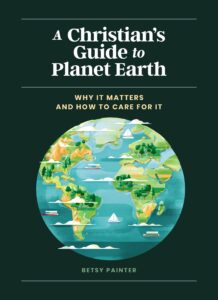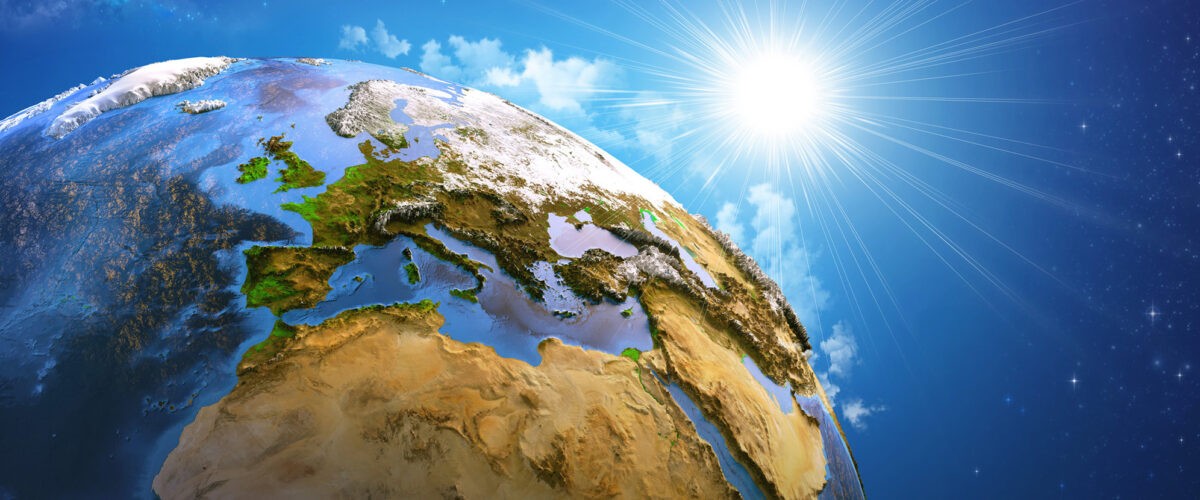What’s your earliest memory in nature? For many of us it occurred right outside our childhood homes. For me, I was wrist deep in dirt, sitting uphill from a creek lined with oaks and willows. With my mom’s garden shovel, I scooped up dirt and molded it into an ant hill and sprinkled grass into the nearby hole to make a bed for grasshoppers. It was an ant and grasshopper duplex.
My childlike faith, fresh as heaven, colored my vision with wonder. Everything I saw and touched was made by God, from the rocks I picked out to the grasshoppers I caught between my fingers. I felt a giddy delight in my responsibility to care for the critters in my yard as I built them homes.

Betsy Painter
God has built us a remarkable home, this planet earth. We can view creation in a variety of ways: as something to be exploited without restraint or as a vague backdrop to the day-to-day activity of our lives, for instance. In my book though, A Christian’s Guide to Planet Earth, I hope to offer a different view. It’s not a new view, rather an ancient way of seeing and interacting with nature that’s part of the deep history of the Christian faith.
I want to invite you to engage with nature and the Creator in a biblical way and wonder at the world through the lens of faith. I hope to stir your heart to love all of God’s creation, to learn to see nature with reverence and kindness. We will reclaim our God-designed connection to the planet and our role in bringing it toward a state of flourishing for God’s glory and as a service to people, particularly vulnerable populations, who depend upon it.
To do this well, we need to equip our minds with the knowledge of how the planet’s systems work. We’ll explore what the best available science reveals to us about diverse environments, from wetlands to mountains.
When I built the ant and grasshopper homes, my motivation was right, but I was wrong about their habitat needs. The ants never noticed their carefully crafted hills, and the grasshoppers (ungratefully) bounded away from their beds. Likewise, without the relevant knowledge, our work can miss the mark. When we study and know creation well, we can cultivate and protect it more effectively.
In my book, I describe 11 distinct ecosystems and areas, their purposes and functions within the planet, and the problems each faces. I explore biblical themes and lessons to help awaken our curiosity and appreciation of our Maker’s creativity and provision. And finally, I offer practical tips for how we can make a difference. My advice is to choose a few of these tips, whichever ones seem most feasible to accomplish, put them into practice, and then build on them from there.
“How we treat the planet, including our purchasing decisions and daily habits, is interwoven with us becoming people who are mindful of each other’s needs.”
I want to help connect our hearts with our actions. I don’t intend to overwhelm or burden, but rather to simplify and focus, to help us live more humbly, with great contentment, and with less anxiety attached to cultural consumerism. How we treat the planet, including our purchasing decisions and daily habits, is interwoven with us becoming people who are mindful of each other’s needs.
My vocation is an unconventional blend of environmental conservation and Christian ministry, and I entered Yale for graduate studies to explore more intentionally and deeply the connection I’ve experienced between the two fields. I’ve had the privilege of working alongside passionate people in the environmental field who impressed me with their perseverance and disdain for apathy in the face of discouraging news regarding one environmental crisis after another. I wrote A Christian’s Guide to Planet Earth because I believe my family in the faith has the reason, the hope and the resources to make a difference.
We have an opportunity to reflect the gospel message of loving things to life. It’s time for the church to step onto the scene amid a struggling creation, roll up our sleeves and get “wrist deep in dirt” to show the world we care about our mutual home. Let’s look at planet earth as Christ does: with plans and visions for restoration, healing and reconciliation with the persistent hope of a Savior who makes all things new.
Join me in this prayer.
Loving Lord of heaven and earth,
Thank you for the detail, care and love you put into creating planet earth. Thank you for sharing this living work of art, a vibrant masterpiece, with us and giving us the eyes, ears and minds to study and delight in all of creation with you. Remind us to receive creation’s provisions with gratitude and through gentle means. Help us do our part in our own unique ways to keep the earth thriving for now, and for future generations.
Please give us the Holy Spirit to renew our minds to see the world as you do. Show us where your earth is broken, lead us to those who are in lack of the planet’s practical provisions, and help us work together as a community of faith to heal and restore. We celebrate your awesome and intricate works and long to engage with all of creation in worship of you. Fill the earth with the knowledge of your glory and the hope of the promised new heaven and new earth through your Son, Jesus.
In his wonderful name we pray. Amen.
 Betsy Painter is a creative writer and conservation biologist who is passionate about environmental care and its human dimensions. She has studied religion and ecology in graduate school with a focus on the beautification of nature in the redemptive biblical narrative and its implications for environmental hope and messaging today. This column is adapted here with permission from A Christian’s Guide to Planet Earth: Why It Matters And How to Care For It by Betsy Painter and Multi. Copyright © 2022 by Karen Elizabeth Painter. Book published by Zondervan, an imprint of HarperCollins Publishers.
Betsy Painter is a creative writer and conservation biologist who is passionate about environmental care and its human dimensions. She has studied religion and ecology in graduate school with a focus on the beautification of nature in the redemptive biblical narrative and its implications for environmental hope and messaging today. This column is adapted here with permission from A Christian’s Guide to Planet Earth: Why It Matters And How to Care For It by Betsy Painter and Multi. Copyright © 2022 by Karen Elizabeth Painter. Book published by Zondervan, an imprint of HarperCollins Publishers.
Related articles:
The seminary professor who blazed a trail for environmental justice among Baptists
Every day is Earth Day for this CBF church
On climate change, the political divide has widened as more Americans overall express concern


